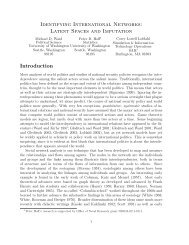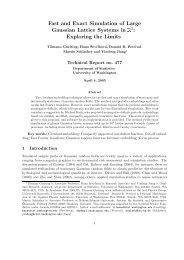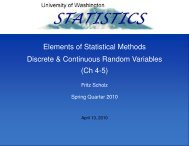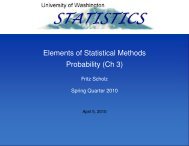View - Statistics - University of Washington
View - Statistics - University of Washington
View - Statistics - University of Washington
You also want an ePaper? Increase the reach of your titles
YUMPU automatically turns print PDFs into web optimized ePapers that Google loves.
3without training data (unsupervised) and without the need for manual fine-tuning<strong>of</strong> parameters (automatic). Although many such methods exist, most assume thatK, the number <strong>of</strong> segments, is known in advance. The basic approaches to imagesegmentation consist <strong>of</strong> three types <strong>of</strong> methods: region growing, edge finding, andpixel classification. Here, I give a brief description <strong>of</strong> these areas.Region growing methods seek homogeneous regions, and then grow and mergethese regions until the desired number <strong>of</strong> segments is reached. The growing ormerging <strong>of</strong> regions is typically controlled by a homogeneity measure, such as anentropy criterion or a least squares measure. A well-known example <strong>of</strong> the latteris Hartigan’s K-means clustering (Hartigan, 1975). In addition to the homogeneitymeasure, regions can be characterized by color, shape, size, and so on; thesemeasurements can be incorporated into the region growing algorithm or used in asubsequent processing step. For example, Campbell et al (1997) generate an initialsegmentation using a simple K-means approach, and then use texture, color, andshape to refine and classify the regions. Although the classification step requiresextensive training data, this approach achieves impressive results, correctly classifyingover 90% <strong>of</strong> the pixels in a set <strong>of</strong> outdoor urban test images into 11 objectclasses.Edge finding methods identify edges in a scene; after linking or extending theseedges to form closed regions, edges can be removed until the desired number <strong>of</strong>segments is attained. A wide variety <strong>of</strong> edge finding and edge enhancing methodsare available, with a corresponding range <strong>of</strong> computational complexity. On thesimpler end <strong>of</strong> the spectrum, high-pass filtering methods can be implemented asconvolution operations with simple kernels (for an introductory review <strong>of</strong> simpleconvolution methods, see Burdick, 1997); these approaches are similar to mathematicalmorphology. Usually, more complicated convolution approaches are used,such as Canny’s edge detection (Canny, 1986). Most convolution methods are very
















